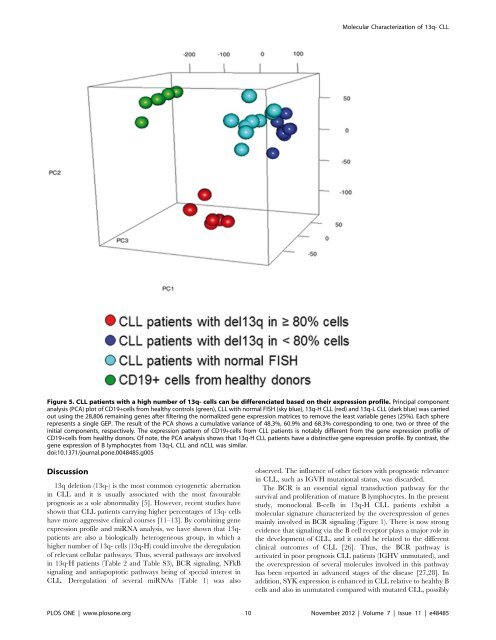Alberto Risueño Pérez - Gredos - Universidad de Salamanca
Alberto Risueño Pérez - Gredos - Universidad de Salamanca
Alberto Risueño Pérez - Gredos - Universidad de Salamanca
You also want an ePaper? Increase the reach of your titles
YUMPU automatically turns print PDFs into web optimized ePapers that Google loves.
Discussion<br />
13q <strong>de</strong>letion (13q-) is the most common cytogenetic aberration<br />
in CLL and it is usually associated with the most favourable<br />
prognosis as a sole abnormality [5]. However, recent studies have<br />
shown that CLL patients carrying higher percentages of 13q- cells<br />
have more aggressive clinical courses [11–13]. By combining gene<br />
expression profile and miRNA analysis, we have shown that 13qpatients<br />
are also a biologically heterogeneous group, in which a<br />
higher number of 13q- cells (13q-H) could involve the <strong>de</strong>regulation<br />
of relevant cellular pathways. Thus, several pathways are involved<br />
in 13q-H patients (Table 2 and Table S3), BCR signaling, NFkB<br />
signaling and antiapoptotic pathways being of special interest in<br />
CLL. Deregulation of several miRNAs (Table 1) was also<br />
Molecular Characterization of 13q- CLL<br />
Figure 5. CLL patients with a high number of 13q- cells can be differenciated based on their expression profile. Principal component<br />
analysis (PCA) plot of CD19+cells from healthy controls (green), CLL with normal FISH (sky blue), 13q-H CLL (red) and 13q-L CLL (dark blue) was carried<br />
out using the 28,806 remaining genes after filtering the normalized gene expression matrices to remove the least variable genes (25%). Each sphere<br />
represents a single GEP. The result of the PCA shows a cumulative variance of 48.3%, 60.9% and 68.3% corresponding to one, two or three of the<br />
initial components, respectively. The expression pattern of CD19+cells from CLL patients is notably different from the gene expression profile of<br />
CD19+cells from healthy donors. Of note, the PCA analysis shows that 13q-H CLL patients have a distinctive gene expression profile. By contrast, the<br />
gene expression of B lymphocytes from 13q-L CLL and nCLL was similar.<br />
doi:10.1371/journal.pone.0048485.g005<br />
observed. The influence of other factors with prognostic relevance<br />
in CLL, such as IGVH mutational status, was discar<strong>de</strong>d.<br />
The BCR is an essential signal transduction pathway for the<br />
survival and proliferation of mature B lymphocytes. In the present<br />
study, monoclonal B-cells in 13q-H CLL patients exhibit a<br />
molecular signature characterized by the overexpression of genes<br />
mainly involved in BCR signaling (Figure 1). There is now strong<br />
evi<strong>de</strong>nce that signaling via the B cell receptor plays a major role in<br />
the <strong>de</strong>velopment of CLL, and it could be related to the different<br />
clinical outcomes of CLL [26]. Thus, the BCR pathway is<br />
activated in poor prognosis CLL patients (IGHV unmutated), and<br />
the overexpression of several molecules involved in this pathway<br />
has been reported in advanced stages of the disease [27,28]. In<br />
addition, SYK expression is enhanced in CLL relative to healthy B<br />
cells and also in unmutated compared with mutated CLL, possibly<br />
PLOS ONE | www.plosone.org 10 November 2012 | Volume 7 | Issue 11 | e48485
















